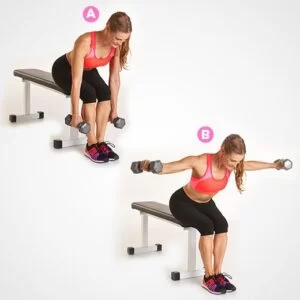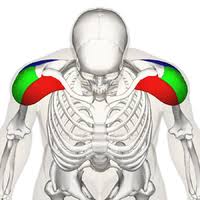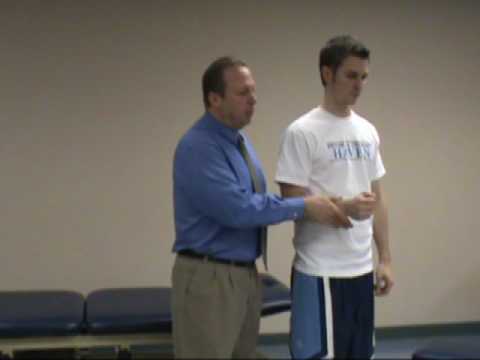Reverse Fly Exercise: Muscle works, Benefits, How to Do?
Reverse fly is an important exercise that helps to strengthen your shoulder muscles mainly the Deltoid and Trapezius and other related scapular muscles.
What is reverse fly exercise?
This is the resistance exercise that utilizes your rear deltoids and major muscles of the upper back. for this exercise only you need a pair of dumbbells, so it can be performed at any place or at home. Add the reverse fly to your daily workout. If you do this exercise in the perfect form then it will also activate your triceps, rhomboids, infraspinatus, and other scapular muscles.
Which muscles are used to perform the reverse fly exercise?
- Primary muscles worked:
- Rear Deltoid muscle, Rotator Cuff muscles
- Secondary muscles worked:
- Trapezius muscle
- Triceps, rhomboids, infraspinatus, and other scapular muscles
Health Benefits of the Reverse Fly Exercise.
- Helps to strengthen the posterior deltoid muscles.
- Helps to strengthen upper back muscles (rhomboids and trapezius).
- Helps to improve bad posture.
- Helps to improve balance.
- Helps to stretch the chest muscles.
- Helps to improve your functional fitness.
- Helps to support your shoulder girdle.
- Decreased pain in the neck/shoulders
- Longer stamina and increased athletic performance
How to Do a Reverse Fly in a Perfect Form?
- For this exercise, you have to stand with feet shoulder-width apart with hold dumbbells in both hands by your sides. move your hips back in a hinge motion, your chest should be forward and almost parallel to the ground. move the weight to hang straight down( both palms facing each other) and engage your core muscles, slight knee flexion, and maintain a straight back.
- now raise both hands by your side with the breath out. your elbows should be slightly flexed. when you pull dumbbells towards the spine your shoulder blades should be squeezed. down the weight back to the initial position by breathing in. Maintain your spine neutral and chin tuck in. Do 10 to 12 repetitions of 2 to 3 sets.
- you may begin with weight free then grab the light weight in your hands. when you become comfortable with low weight then gradually increase the weight.
Reverse Fly Exercise
There are different Variations of the Reverse Fly.
Seated Reverse Fly
How to do it?
- For this exercise, you have to sit on a bench. grab dumbbells in both hands by your sides. move your hips back in a hinge motion, your chest should be forward and almost parallel to the ground. move the weight to hang straight down( both palms facing each other) and engage your core muscles, slight knee flexion, and maintain a straight back.
- now raise both hands by your side with the breath out. your elbows should be slightly flexed. when you pull dumbbells towards the spine your shoulder blades should be squeezed. down the weight back to the initial position by breathing in. Maintain your spine in a neutral position. Do 10 to 12 repetitions of 1 to 2 sets.
- If a standing position is not tolerated by the person then go for this variation.
Upright Reverse Fly With Resistance Band
How to do it?
- For this exercise, you will need a resistance band. you can do this exercise in a standing or sitting position. you have to stand on a resistance band withhold both ends in your hands. slightly flex your knees and move your back lower down so it is parallel to the ground. Elevate your arms by raising as much as you can. pause for 2 seconds then lower the band to the starting position and go for the next repetitions. Do 10 to 15 repetitions of 2 to 3 sets.
Prone Reverse Fly
How to do it?
- For this variation, you have to lie prone on a stability ball or bench to decrease low back discomfort. This exercise more focuses on muscle movement and preventing injury. grab a dumbbell in both hands by your sides. move your hips back in a hinge motion, your chest should be forward and almost parallel to the ground. move the weight to hang straight down( both palms facing each other) and engage your core muscles, slight knee flexion, and maintain a straight back.
- now raise both hands and move away from the body with the breath out. your elbows should be slightly flexed. when you pull dumbbells towards the spine your shoulder blades should be squeezed. down the weight back to the initial position by breathing in. Maintain your spine in a neutral position. Do 10 to 20 repetitions of 2 to 3 sets.
Reverse Fly With Lunge
How to do it?
- Once you have mastered in above varieties of this exercise then go for this variation. This is an advanced exercise that can increase the instability of movement.
- For this exercise you have to stand in a lunge position one leg should be forward with knee flexion and one leg should be straight and backward. In this position grab a dumbbell in your hands by your side and move your trunk inflection. now raise the dumbbells away from the body. hold for two seconds then back to the initial position. Go for the next repetitions in the same manner. Do 8 to 12 repetitions of 2 to 3 sets.
Common Mistakes happen while performing the Reverse fly exercise. you should avoid these mistakes to get more benefits from this exercise and do exercise safely and effectively.
Rounding the Back
Avoid rounding the back during this exercise, This will place too much stress on your lower spine and lead to a low back. This mistake is easily corrected by paying attention to the body position while moving. your core muscles should be tight, chin tuck in, and have a straight back to effectively do the movement.
Swinging the Weight
Always do a slow, controlled movement while performing the reverse fly. Swinging the weight uses momentum instead of muscle use to raise the arms by the side. Strengthening the muscle is not a race to the finish but a slow and steady process is necessary.
Lifting Too Heavy
If you will lift too much weight it will lead to strain on your shoulder, back, and neck. reduce the weight will allow comfortable movement and good form.
Safety and Precautions
Weight training exercises require more attention to your body position, form, and function. doing any resistance workout improperly can increase the injury risk. Consult your doctor if you have shoulder and back issues. If you notice pain during this exercise then stop doing this exercise and move to the next exercise which works on the same area.
When did you not do this exercise?
- If you feel any pain or discomfort during this exercise then stop immediately and consult your health care provider.
- If your shoulder is recently injured.
- If you are already suffering from back or shoulder pain.
- If your physician is advised you should take a rest.
- If you have recently undergone any surgery.







